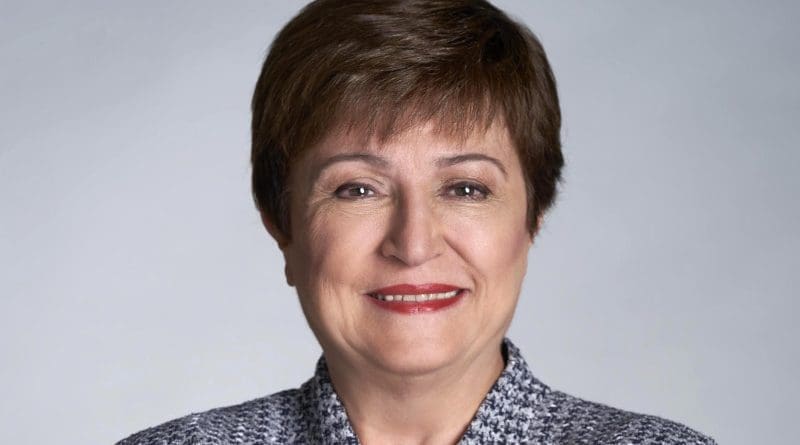IMF Managing Director Kristalina Georgieva At Insurance Development Forum Summit – Speech
It is a great pleasure to join you today at the Insurance Development Forum, together with my dear friends David Malpass and Mark Carney. I also want to thank Denis Duverne for his leadership in helping the financial sector cope with the tremendous challenge of climate change.
Let me start with a quote from one of my favorite authors, Leo Tolstoy. He wrote: “One of the first conditions of happiness is that the link between humans and nature shall not be broken.”
We need to recognize that we are very close to breaking this link. That would mean not only a big dent in our happiness, but also a danger for the future of our children and grandchildren. So, the topic in front of us is very serious. And it does require our institutions and each and every one of us to take a stronger stance in the face of rapidly growing climate risks.
No doubt, the insurance industry plays a tremendously important role. I want to highlight the role of the IMF and how it links to the insurance industry as we build stronger resilience to climate change, while seizing the opportunities of the climate transition.
For the IMF, the mandate is clear: promoting macroeconomic and financial stability, growth and employment. And of course, there is no way for us to deliver on this mandate if we ignore the significance of climate change.
Let me focus on three aspects:
First, building resilience to climate shocks and accelerating the transition to the new climate economy. Second, identifying and managing climate-related financial risks for the insurance industry itself. And third, unlocking the potential of the insurance industry as a source of financing in this transformation.
Building resilience
On the first issue—resilience to climate shocks—it is fair to say that the insurance industry was ahead of others, because of the link between weather-related events and insurance claims. We have seen significant advancements in climate risk monitoring and modeling, and in integrating those risks into insurance products. I want to commend the industry for these efforts.
For the IMF, the link is very clear. We have been stepping up our work with our membership on building resilience to climate risks—by deepening our understanding of these risks and the ways to reduce them. How can economies be better prepared for the increasingly damaging effects of climate change? And how can we build forward better in light of these risks?
On all these issues, we rely on the insurance industry’s work on risk assessment, which we are integrating into our own assessments. This includes our regular country assessments, where we take the pulse of economies, as well as our financial sector assessments, the so-called FSAPs.
How we can integrate insurance sector expertise and products in building resilience is something that the IMF has embraced. We identify best practices and share them across our membership. We support countries in developing and adopting insurance products that are forward leaning. And we work hard to help countries expand insurance coverage—not just at the level of the sovereign, but also for businesses and households.
Making insurers more resilient
The second issue is the assessment and management of climate-related risks within the insurance industry, especially in light of more frequent and larger claims. What matters more than anything else is the quality of disclosure standards, data, and stress-testing for these risks.
Here I want to second Mark Carney: the agreement by the G7 to move towards mandatory disclosure of climate-related risks and to standardize reporting of these risks is critical. I very much hope that the G20 will embrace it and that, by COP26, we will be living in a better-organized world.
The fact is that there are still some 200 frameworks for reporting. It was good to have more flowers blooming 10 years ago. But now is the time to turn these flowers into a nice bouquet—and to enjoy its beauty at COP26—so we can get to standardized reporting. These efforts are underway across the financial sector, including the insurance industry.
The IMF will contribute by moving to stress-testing for these risks and, as standardized reporting gets developed, integrating it in our financial sector assessments. As you probably know, these FSAPs cover some 12 countries per year. We have already included climate-related risks in one in five of these assessments, and our goal is to move to full coverage within 18 months. I am confident that this will also lead to a better understanding of these risks within the insurance sector.
Insurance money for green finance
My final point is on mobilizing financing. Fund research shows that a green infrastructure push—coordinated across economies—can boost global GDP in the next 15 years by 0.7 percent per year, creating millions of new jobs. But how can we mobilize the money? So far, the insurance industry has been facing barriers to investment.
In many emerging and developing economies, insurers are still prohibited from investing in infrastructure projects, or they can do so only within very tight limits. Also, capital requirements often overestimate the risk of those investments. Reducing regulatory barriers and reflecting risks more accurately can be a global game changer.
So, we are very keen to work with the industry on advancing policies in all these three areas. We are extremely grateful for the opportunity to learn from others today. Together we can accelerate this historic transition to a greener and more resilient economy.
Thank you very much.

